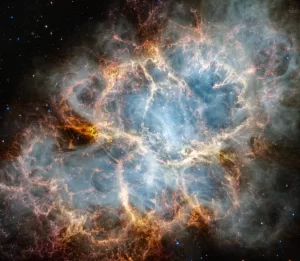Why can’t I see fabulous coloured nebulae with my telescope?

We are all used to seeing fabulous, colourful images from space, taken by the Hubble Space Telescope or from some of the world’s best observatories, and I know this prompts many people to want to buy their own telescopes with expectations of seeing these delights first hand, only to result in disappointment and disillusionment.
Sadly, the truth is that the full beauty of many of these images is only revealed using long exposure photography, and what can be seen through a telescope with the eye has some fundamental limitations, which apply no matter how big and expensive your telescope is.
No telescope makes distributed objects such as NEBULAE, GALAXIES and (most) PLANETS appear brighter than they can be seen with the naked eye.
Most people are very surprised by this statement, and many assert that it cannot possibly be true. The reason why is a bit difficult to explain but bear with me, and I shall try.
Astronomical telescopes typically have a large lens at the front called the objective lens, and an arrangement of smaller lenses at the back (or side) which you look through called the eyepiece. There are other designs using mirrors and combinations of mirrors and lenses too, but they all suffer from the same fundamental limitation.
The role of the objective lens is to collect as much light as possible, and the larger it is, the more light it can collect. The role of the eyepiece is to focus and magnify the image, and telescopes often have a choice of eyepieces providing different magnifications.
Any telescope has to do at least the following two basic things…
1) The telescope has to magnify the image – spreading the collected light over a wider area of your retina. Hopefully, it will already be obvious that this ‘spreading’ makes an image appear dimmer.
2) The telescope has to shrink the wide, cylindrical column of light entering the objective lens into a far smaller column of light exiting the eyepiece (the width of this narrow column of light is actually known as the exit pupil),
The two effects go hand in hand. More magnification means a bigger image on the retina, but with a smaller exit pupil, and vice versa.
Now for the maths, which I’ll keep as simple as possible.
Assume some round numbers…
An object lens of 500mm diameter
A eye pupil of 5mm diameter
Obviously, the objective lens is 100 times wider than a human pupil, and so collects 10,000 times more light than the human eye (as the light collecting area is 10,000 times bigger)
But to shrink that 500mm diameter column of light into a 5mm exit pupil requires a magnification of 100x. At this magnification the brightness of the image is reduced 10,000 fold – so the image brightness is then just the same as seen with the naked eye. This assumes perfect, lossless telescope optics of course.
So what if we magnify only 50x? Won’t this make the image 4x brighter? Well yes, it would EXCEPT that the column of light leaving the eyepiece is now 10mm in diameter – which is too wide to fit through your 5mm wide eyes. Most of the light energy is spilling uselessly onto your iris. Only a quarter will pass through into your eye. So there is no improvement. The image remains the same brightness.
So what if we tried a 200x magnification? Well that makes the exit pupil 2.5mm across (which is fine – all of the light energy now goes through the 5mm pupil of your eye) but the larger image is now 4x fainter because of the 2x increase in magnification. So this is WORSE than before.
And so – in summary – for any telescope / eye combination, you can divide the size of the object lens, by the size of your pupil to give the maximum magnification you can apply before the image starts to get fainter. (Young people have a pupil which can dilate to 7mm, older folk can’t dilate more than about 5mm). At any magnification below this, the brightness of the image is a constant value which is exactly the same as you would see unaided.
Things to note:
1) This analysis and frustrating conclusion apply to relatively large objects like nebulae, galaxies and (most) planets. But it does NOT apply to the brightness of stars, for a very interesting and curious reason…
Stars are so far away that they are effectively point objects. No amount of magnification will render the image on the back of your retina to be bigger than a single light-sensitive cell, so magnification DOES NOT REDUCE the brightness of stars – so (say) a 12″ Dobsonian will give you FABULOUS views of faint star clusters.
2) Bigger magnification makes SPACE appear darker too, so not only do stars seem brighter, their contrast against the background improves with magnification too. But with nebulae and galaxies, the two effects go hand in hand, so there’s no contrast improvement relative to the naked eye for those objects.
3) I acknowledge that the magnitude of Neptune is improved with a telescope. I suspect this can be accounted for by its very small angular size, which exists at around the size boundary between a point object and a distributed one.
Footnote: Thank you for the many comments I’ve received on this article. I think it fair of me to acknowledge that a lot of people have disputed the conclusions in this post, but not the reasoning.
By Kevin Pretorius
Dec 2009
